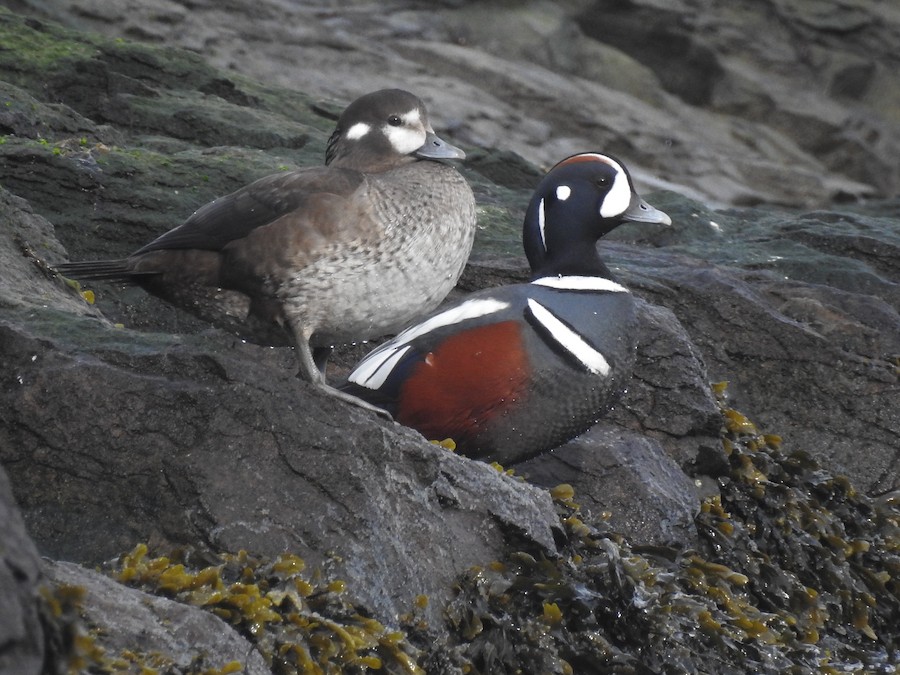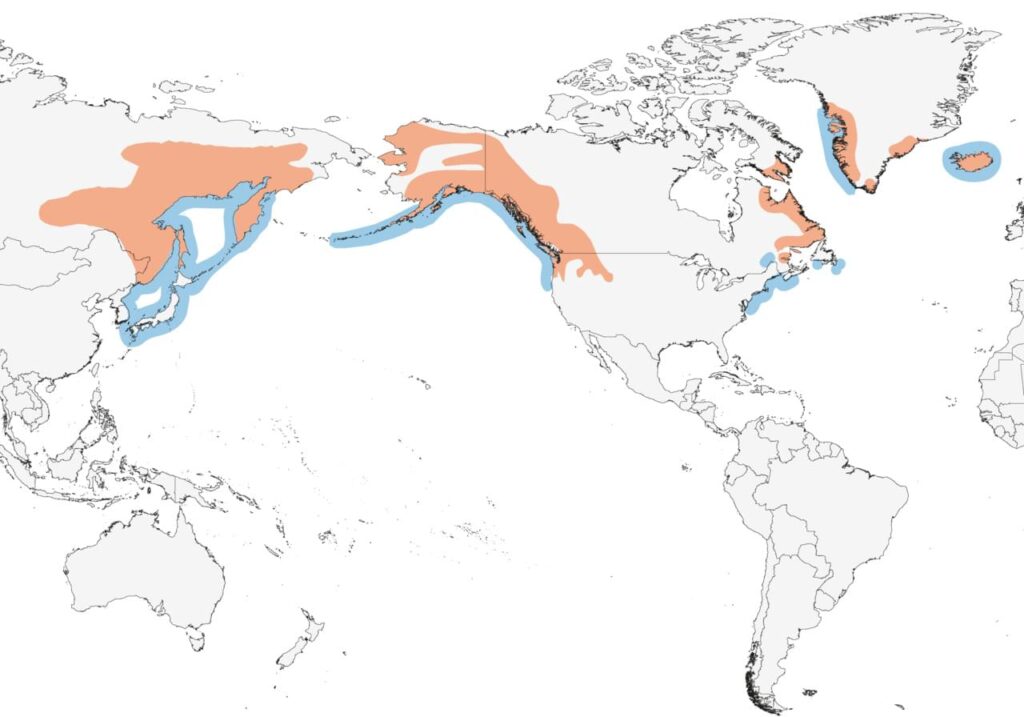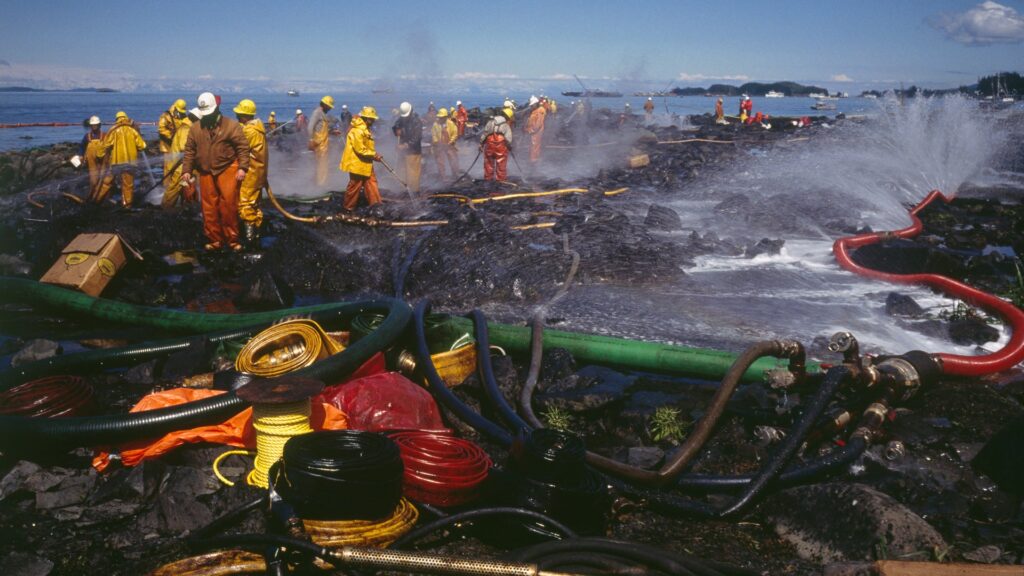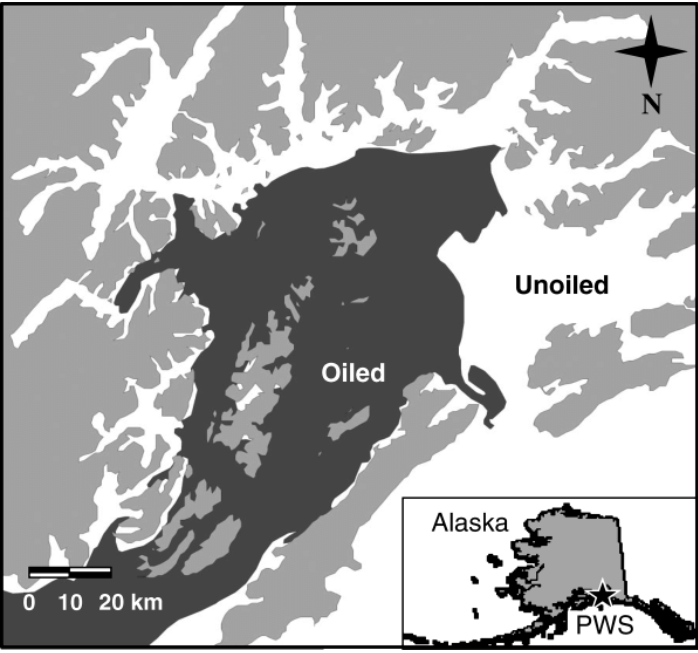A Harlequin Duck (Histronicus histronicus) makes a mesmerizing sight as it floats atop the waves of the windswept coast. The striking beauty of the male’s geometric pattern is matched only by its grit, as they migrate between freezing ocean waters and fast flowing alpine streams (Sibley, 2016).
Identification
The body plan of the Harlequin Duck is small and compact, with a large head atop a short neck. The short bill and steep angle of the forehead gives a distinct silhouette, although often the best identification is in their plumage (Cornell Lab of Ornithology, n.d.). Male plumage during the breeding season is one of the most intricate and beautiful of any sea duck: a slate grey body with large chestnut patches on the sides, adorned with white stripes (Sibley, 2016). In flight, a metallic blue speculum can be observed, a patch of iridescence on the wing (Riley & Johnson, 2010). The head features a white crescent in front of a dark eye, and a white spot on the cheek. Though females lack the flashy colouration of body and wing, they retain the white cheek and general lightness around the eye and bill. The overall body of the female is a brown-grey, which is also observed in juvenile birds of both sexes (Sibley, 2016).

Female and male Harlequin Ducks sitting on rocks near Nanoose Bay, Canada (Wermeskerken, 2017).
Their call paints a picture of a much different bird than the sleek and durable duck it comes from. The high, chattering squeak has earned them the colloquial nickname “sea mice” (Cornell Lab of Ornithology, n.d.).
Audio recording of Harlequin Ducks calling (Spencer, 2014).
Distribution
Harlequin ducks are divided into two distinct populations. Despite belonging to the same species, the Western and Eastern populations are genetically distinct (Scribner et. al., 2024). The more abundant Western population is found from Alaska through the Pacific Northwest, as well as northeast Siberia and Japan; The Eastern population inhabits eastern Canadian provinces, the northeast United States, Greenland, and parts of Iceland (Riley & Johnson, 2010).

Range map of Harlequin Ducks. Blue areas represent their wintering habitat, and orange areas represent breeding grounds (Audubon, n.d.).
Habitat
Harlequin Ducks are rarely observed in breeding season, as they prefer to breed in fast flowing subalpine streams and rivers (Sibley, 2016). Their tendency to breed in relatively inaccessible areas contributes to the gaps in knowledge regarding the breeding behaviour of these birds. A team out of the University of Michigan is currently researching the viability of testing for Harlequin Duck DNA in streams to identify possible nesting sites (Kimball, 2024).
A breeding pair of Harlequin Ducks in the Sol Duc River, Washington State USA. The pair express a high degree of comfort swimming in the fast-moving water of the river, particularly just before the 2 minute mark (Evergreen Wilderness, 2021).
After a relatively short migration Harlequin Ducks spend the winter months along the rocky coastal shorelines, seeming to favour the exposed coastline over protected inlets. A lifetime along the windswept coasts can take a toll on the bodies of these birds, as X-ray analysis found that many adult Harlequins live with healed bone fractures (Cornell Lab of Ornithology, n.d.). Harlequins are highly philopatric with their wintering grounds, meaning a bird will return to the same location many years in a row (Iverson et. al., 2004). The rate of returning birds was determined to be between 92-96%, using mark-recapture survey in Prince William Sound, Alaska (Iverson et. al., 2004).
Diet
In the nonbreeding season Harlequin Ducks use their impressive diving ability to retrieve a variety of marine invertebrates, with snails, clams, and mussels making up the majority of their winter diet (Rodway, 1998). Once the Pacific Herring spawn begins in late winter, herring eggs become the primary food source for those near spawning areas (Rodway & Cooke, 2002). At their alpine nesting sites their diet is primarily made of aquatic insect larvae such as midges and blackflies, which accommodates the skimming feeding strategy employed by hatchlings (Rodway, 1998).
Breeding
Harlequin Ducks reach sexual maturity between the ages of two or three years old, which is later than many other species of ducks (Cornell Lab of Ornithology, n.d.). They are seasonally monogamous, choosing one mate for the breeding season, but some form multi-year pairs. (Robertson et. al., 1998). Males attract mates through their flashy plumage as well as courtship behaviours such as head bobbing and whistling (Cornell Lab of Ornithology, n.d.). Both the male and female participate in nest building, but the male typically leaves the breeding grounds once the female starts to incubate (Cornell Lab of Ornithology, n.d.). A clutch of 4-8 eggs is incubated for 27-29 days, and upon hatching the chicks are downy and able to leave the nest almost immediately (Audubon, n.d.).
20 hour old Harlequin ducklings at the Patuxent Wildlife Research Center, Maryland. (Fiely, 2016).
Current Research
Research on Harlequin Ducks over the past decades has had a strong focus on an event that occurred more than thirty years ago: The Exxon Valdez oil spill. One of the worst environmental disasters in history, the spill occurred in March of 1989 when an oil tanker ran aground in Prince William Sound, Alaska, and spilled 11 million gallons of oil into the surrounding water. (Environmental Protection Agency, n.d.) The spill had huge impacts on marine life, including the death of an estimated 100,000 – 300,000 sea birds (Piatt et. al. 1990). Included in that mortality is an estimated 25% of the Harlequin duck population that was wintering in the sound (Iverson & Esler, 2010).


Cleanup crew on the Alaskan coast following the Exxon Valdez oil spill (Atlan,1989)
Map of the affected area of Prince William Sound, following the Exxon Valdez oil spill. (Iverson & Esler, 2010)
Even after the direct mortality caused by the spill, sea life continued to feel the effects. Harlequin Duck populations are particularly vulnerable to environmental disasters such as oil spills due to their delayed age of sexual maturity and their tendency to return to the same wintering grounds over many years. Surveys in the following years concluded that the mortality of Harlequin Ducks from chronic oil exposure was higher than the deaths in the immediate aftermath of the spill (Iverson & Esler, 2010).
Over the past decades, researchers have used blood sampling in Harlequin Ducks to find signs of oil exposure. By analysing the levels of an enzyme called EROD, they can obtain an indirect measurement of proteins that are produced in response to foreign chemicals in the body (Weins, 2007). Studies involved sampling Harlequin Ducks from oiled and unoiled wintering grounds and using the relative EROD levels to determine if the ducks were still impacted by oil exposure. Between 2005 and 2009, EROD activity was five times higher in ducks using oiled wintering grounds than it was in the non-oiled areas (Esler et. al., 2010). A repeat of that study in 2011 found EROD levels doubled in the oiled area ducks relative to non-oiled area ducks, and no significant difference in the levels for 2013 and 2014. (Esler et. al., 2017) This implies that for 22 years after the spill, Harlequin Ducks wintering in Prince William Sound were exposed to residual oil! These series of studies following the Exxon Valdez oil spill provided a basis for oil exposure measurement in seabirds using EROD activity, and similar studies are being conducted on an ongoing basis to gain better understanding of the ecological impact of oil spills.
Thank you for reading my blog on the beautiful Harlequin Duck! I hope you’ve learned something new, and please feel free to leave a comment below.
References
Audubon. (n.d.) Harlequin Duck. Audubon. https://www.audubon.org/field-guide/bird/harlequin-duck
Atlan, J. (1989). Oil Spill in Alaska. [Photograph]. Getty Images. https://www.gettyimages.ca/detail/news-photo/teams-of-firefighters-cleaning-the-alaskan-coast-following-news-photo/542342318?phrase=Exxon+Valdez+Oil+Spill&adppopup=true
Cornell Lab of Ornithology. (n.d.) Harlequin Duck. All About Birds. https://www.allaboutbirds.org/guide/Harlequin_Duck/overview
Environmental Protection Agency. (n.d.). Exxon Valdez Spill Profile. EPA. https://www.epa.gov/emergency-response/exxon-valdez-spill-profile
Esler, D., Ballachey, B., Bowen, L., Miles, A., Dickson, R. & Henderson, J. (2017). Cessation of oil exposure in harlequin ducks after the Exxon Valdez oil spill: Cytochrome P4501A biomarker evidence. Environmental Toxicology and Chemistry, 36. 1294-1300. https://doi-org.ezproxy.viu.ca/10.1002/etc.3659
Esler, D., Trust, K., Ballachey, B., Iverson, S., Lewis, T., Rizzolo, D., Mulcahy, D., Miles, A., Woodin, B., Stegeman, J., Henderson, J., & Wilson, B.W. (2010). Cytochrome P4501A biomarker indication of oil exposure in harlequin ducks up to 20 years after the Exxon Valdez oil spill. Environmental Toxicology and Chemistry, 29. 1138-1145. https://doi-org.ezproxy.viu.ca/10.1002/etc.129
Evergreen Wilderness. (2021). Harlequin Ducks | Sol Duc River. [Video]. Youtube. https://www.youtube.com/watch?v=4m_0gKLkdP4&t=4s
Fiely, J. (2016). First Days- Harlequin Ducks. [Video]. USGS. https://www.usgs.gov/media/videos/first-days-harlequin-ducks
Iverson, S., & Esler, D. (2010). Harlequin Duck population injury and recovery dynamics following the 1989 Exxon Valdez oil spill. Ecological Applications, 20(7), 1993–2006. https://doi.org/10.1890/09-1398.
Iverson, S., Esler, D., Rizzolo, J. (2004). Winter Philopatry of Harlequin Ducks in Prince William Sound, Alaska. The Condor, 106(3), 711-715. https://doi.org/10.1093/condor/106.3.711
Kimball, J. (2024). Are Harlequin ducks back in the Bitteroot?. TCA Regional News
Piatt, J., Lensink, C., Butler, W., Kendziorek, M., & Nysewander, D. (1990). Immediate Impact of the ‘Exxon Valdez’ Oil Spill on Marine Birds. The Auk, 107(2), 387-397. https://doi.org/10.2307/4087623
Riley, A. & Johnson, M. (2010) Histronicus histronicus. Animal Diversity Web. https://animaldiversity.org/accounts/Histrionicus_histrionicus/#df1c69af0984f6d137cb96851bbbf759
Robertson, G. J., Cooke, F., Goudie, R. I., & Boyd, W. S. (1998). The Timing of Pair Formation in Harlequin Ducks. The Condor, 100(3), 551–555. https://doi.org/10.2307/1369723
Rodway, M. (1998). Activity patterns, diet, and feeding efficiency of Harlequin Ducks breeding in northern Labrador. Canadian Journal of Zoology, 76(5), 902-909. https://doi.org/10.1139/z98-019
Rodway, M., & Cooke, F. (2002). Use of Fecal Analysis to Determine Seasonal Changes in the Diet of Wintering Harlequin Ducks at a Herring Spawning Site. Journal of Field Ornithology, 73(4), 363–371. https://www.jstor.org/stable/4131161
Scribner, K.T., Talbot, S.L., Pierson, B.J., Robinson, J.D., Lanctot, R.B., Esler, D. and Dickson, K. (2024). A phylogeographical study of the discontinuously distributed Harlequin Duck (Histrionicus histrionicus). Ibis, 166. 1218-1240. https://doi.org/10.1111/ibi.13336
Sibley, D. (2016). Sibley Birds West: Field guide to birds of western North America. Alfred A. Knopf.
Spencer, A. (2014). Harlequin Duck. [Audio Recording]. Xeno-Canto. https://xeno-canto.org/181783
Wermeskerken, C. (2017). Harlequin Duck. [Photograph]. Macaulay Library. https://macaulaylibrary.org/asset/51436371
Wiens, J. (2007). Applying Ecological Risk Assessment to Environmental Accidents: Harlequin Ducks and the Exxon Valdez Oil Spill. Bioscience, 57(9) 769-777. https://doi.org/10.1641/B570909

This Blog Post is very interesting to read Ember. I was not aware of the Exxon Valdez Oil Spill before today, but it is deeply concerning the degree of impact a single event can have on a species, even 30 years later. In the studies, was the general health of the ducks living in oiled compared to non-oiled areas compared? I would be really interested to know how the reproductive success of the birds nesting the oiled areas were impacted.
You mentioned it is hard to study the Harlequin duck’s breeding behaviour because of the inaccessible areas they breed in, but I was hoping they had found out something. I was wondering what type of nest, if any, they make in such hard to reach places? Structurally, they must be very stable to stay near such fast moving streams and rivers.
Hi Grace, I’m glad my blog could teach you something new about the Harlequin Duck. Regarding the effect of the oil spill on survival, it was observed by Iverson and Esler that the winter survival rate was 5.7% lower in the oiled areas up until the early 2000’s. Young females were found to be the most effected, which definitely didn’t help the population bounce back. When studies were repeated in 2010, they didn’t find any significant difference in winter survival rates (although the reports for the EROD biomarker show there was still enough oil present to cause physiological changes!).
Harlequins are ground nesters, so they make shallow nests of grasses and twigs underneath bushes or hidden by rocks. They’re occasionally known to nest in tree cavities, but it’s not typical behavior for them.
Thanks for your insightful questions!
Awesome blog post Ember! It’s fascinating to learn more about these gorgeous ducks! You mentioned that breeding behaviour is understudied in this species due to their difficult to access breeding grounds, but I was wondering if its known why they mate in fast flowing streams? it seems like this method of breeding would be much more energetically expensive! Could it have something to do with predator avoidance or female choice in selecting mates?
Hi Tyler, thanks for reading! I think avoiding predation is a major factor for why Harlequin Ducks breed in alpine streams and rivers, like you suggested. I’m not aware of any research that has been done on that precise topic, but ducks observed in their breeding habitat often dive into the water if they feel threatened, instead of flying away. They could certainly outswim a mink or eagle, so using their ability to navigate those rapid waters would be advantageous. The idea of swimming skills as a form of mate selection is intriguing, but I believe pair bonds form prior to migration so the male would only have had time to show off in the ocean waves.
Thanks again for your interest!